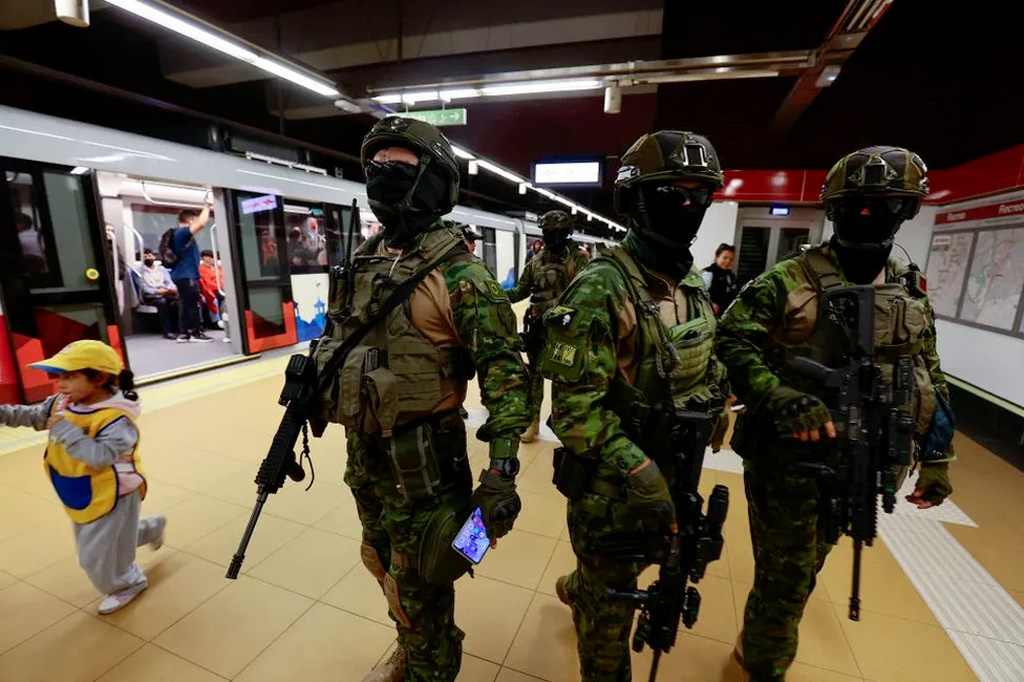President Daniel Noboa declared a “Nationwide State of Emergency” in Ecuador
ITK Voyage Ecuador closely monitors the situation in Ecuador, where a state of emergency and a state of “internal armed conflict” were declared on January 8, 2024, by Ecuadorian President Daniel Noboa, following the escape of a high-profile figure in the drug trade.
- Monday February 6th, 2024. Summary table of risk levels and curfews
- Update, Monday January 15th, 2024
- Areas with security concerns (map)
- Overview
- Ecuador Tourism Ministry to our travelers
- What is the “state of internal armed conflict”?
- Live Hostage-taking on Ecuadorian Television
- The Pan-American highway and the Pujilí market now (January 10, 2024)
Monday February 6th, 2024. Summary table of risk levels and curfews
This table presents the new curfew modalities in Ecuador, in effect since January 23, 2024. The curfew is adapted by province according to the level of security.
| Level | Regions/Provinces | Hours | Exceptions |
|---|---|---|---|
| High | CAÑAR : La Troncal EL ORO : Arenillas, Huaquillas, Machala, Pasaje, Santa Rosa ESMERALDAS : Quinindé, San Lorenzo GUAYAS: Durán, Guayaquil, Balao, Balzar, Daule, El triunfo, El Empalme, Milagro, Naranjal, Naranjito, Playas, San Jacinto de Yaguachi LOS RIOS : Babahoyo, Buena Fe, Pueblo Viejo, Quevedo, Valencia, Ventanas, Vinces MANABI : Manta, Montecristi, Pedernales, Portoviejo PICHINCHA : Quito SANTA ELENA : La Libertad, Salinas, Santa Elena SANTO DOMINGO DE LOS TSACHILAS : Santo Domingo SUCUMBIOS : Lago Agrio |
From midnight to 5 AM | Persons traveling for health reasons, emergency, work, and people going to and from the airport |
| Medium | AZUAY : Cuenca, Camilo Ponce Enríquez CAÑAR : Azogues CARCHI : Tulcán CHIMBORAZO : Riobamba EL ORO : El Guabo ESMERALDAS : Atacames GUAYAS : Samborondón, Colimes, Lomas de Sargentillo, Nobol, Pedro Carbo, Simón Bolívar LOS RIOS : Baba, Mocache, Urdaneta. MANABI : El Carmen, Sucre. MORONA SANTIAGO : Morona NAPO : Tena ORELLANA : La Joya de los Sachas PICHINCHA : Cayambe SANTO DOMINGO DE LOS TSACHILAS : La Concordia |
From 2 AM to 5 AM | Same exceptions as above |
| Low | AZUAY : El Pan, San Fernando, Chordeleg, Girón, Guachapala, Gualaceo, Nabón, Oña, Paute, Pucará, Santa Isabel, Sevilla de Oro, Sigsig BOLIVAR : Caluma, Chillanes, Chimbo, Echeandía, Guaranda, Las Naves, San Miguel CANAR : Biblián, Cañar, Deleg, El Tambo, Suscal CARCHI : Bolívar, Espejo, Mira, Montufar, San Pedro de Huaca CHIMBORAZO : Alausí, Chambo, Chunchi, Colta, Cumandá, Guamote, Guano, Pallatanga, Penipe COTOPAXI : La Maná, Latacunga, Pangua, Pujilí, Salcedo, Saquicilí, Sigchos EL ORO : Atahualpa, Balsas, Chilla, Las Lajas, Marcabelí, Piñas, Portovelo, Zaruma ESMERALDAS : Eloy Alfaro, Muisne, Río Verde GALAPAGOS : San Cristóbal, Isabela, Santa Cruz GUAYAS : Alfredo Baquerizo Moreno, Marcelino Maridueña, Isidro Ayora, Palestina, Salitre, Santa Lucía IMBABURA : Antonio Ante, Cotacachi, Ibarra, Otavalo, Pimampiro, San Miguel de Urcuquí LOJA : Calvas, Catamayo, Celica, Chaguarpamba, Espíndola, Gonzamaná, Loja, Macará, Olmedo, Paltas, Pindal, Puyando, Quilanda, Saraguro, Sozoranga, Zapotillo LOS RIOS : Montalvo, Palenque, Quinsaloma MANABI : 24 de mayo, Olmedo, Bolívar, Chone. Flavio Alfaro, Jama, Jaramijó, Jipijapa, Junín, Paján, Pichincha, Puerto López, Rocafuerte, San Vicente, Santa Ana, Tosagua MORONA SANTIAGO : Gualaquiza, Huamboya, Limón Indanza, Logroño, Palora, Santiago, Sucúa, Taisha, Pablo Sexto, Tiwintza, San Juan Bosco NAPO : Archidona, Carlos Julio Arosemena Tola, El Chaco, Quijos ORELLANA : Aguarico, Loreto, Orellana PASTAZA : Arajuno, Mera, Pastaza, Santa Clara PICHINCHA : Mejía, Pedro Moncayo, Pedro Vicente Maldonado, Puerto Quito, Rumiñahui, San Miguel de los Bancos SUCUMBIOS : Cascales, Cuyabeno, Gonzálo Pizarro, Putumayo, Shushufindi, Sucumbíos TUNGURAHUA : Ambato, Baños de Agua Santa, Cevallos, Mocha, Patate, Quero, San Pedro de Pelileo, Santiago de Pillaro, Tisaleo ZAMORA CHINCHIPE : Centinela del Cóndor, Chinchipe, El Pangui, Palanda, Paquisha, Yantzaza, Zamora, Nangaritza, Yacuambi |
No corfew | None |
Ecuador, Monday January 15th, 2024
Not far from the ITK office, the quiet streets of Sangolqui (Friday, January 12, 2024).
A few days after the events that shook the world, the streets are calm, businesses have resumed their activities, and so have the passersby. Below are some snapshots taken on Friday, January 12, 2024, in the streets near the ITK Voyage Ecuador & Galapagos agency in Sangolqui, in the metropolitan area of Quito.
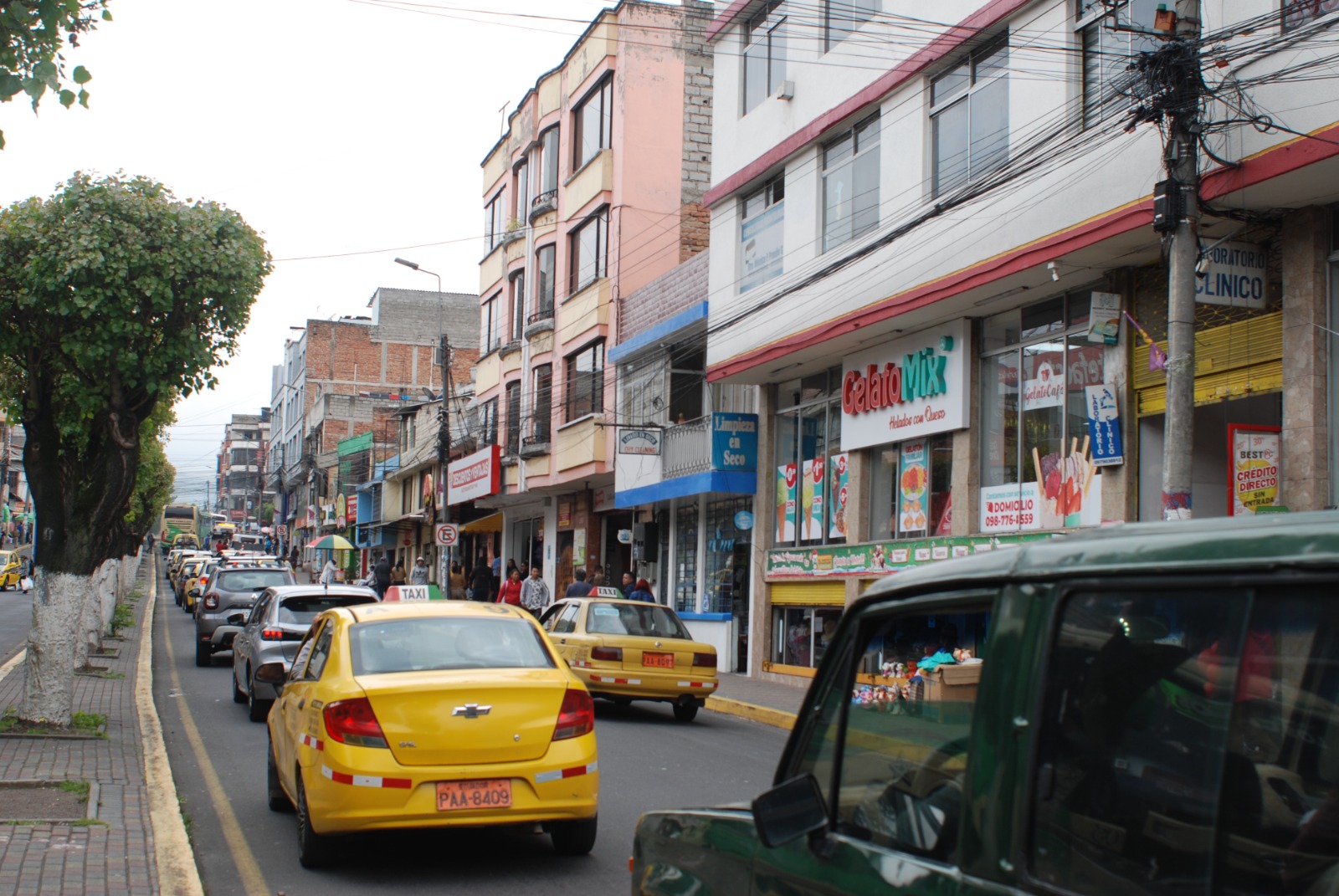
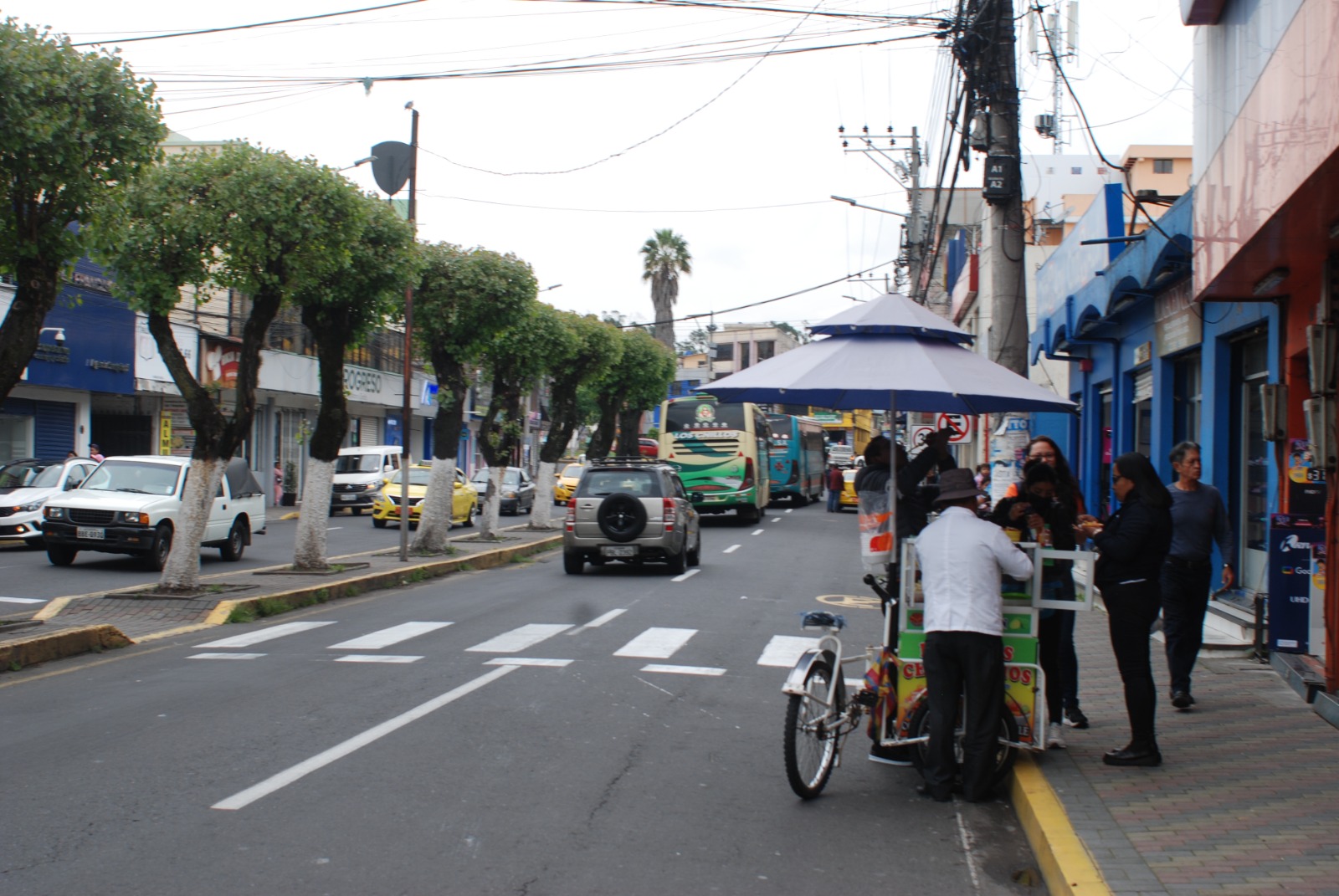
Areas with security concerns
New updated map and identified risk zones (January 13, 2024).
The Canadian Embassy reports the presence of minefields in the south and southeast of the border with Peru. Major cities in Ecuador, such as Quito, except for coastal cities, are again classified as a “zone of usual caution.”
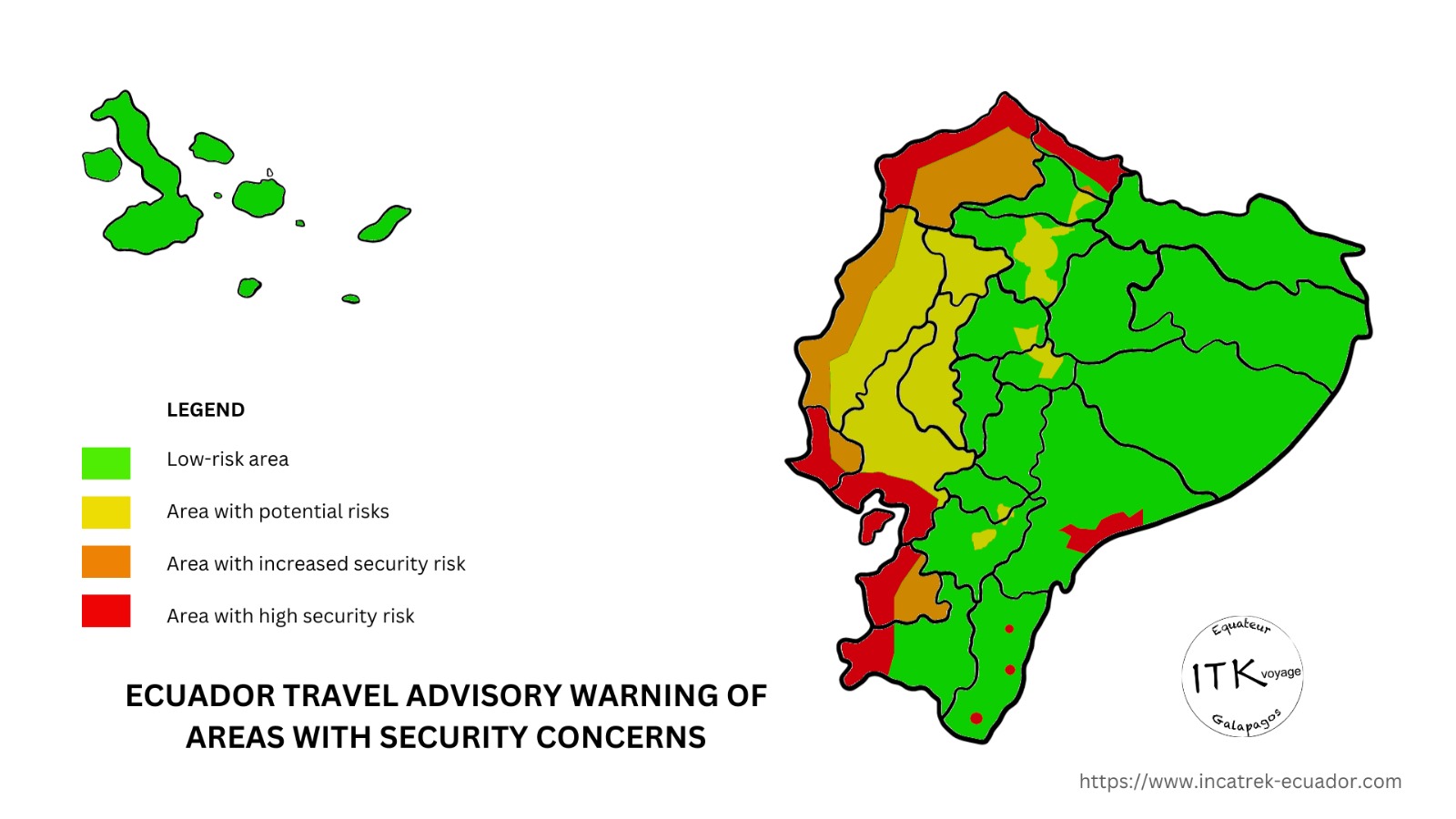
Ecuador to avoid for security reasons, as of January 9, 2024.
The coastal areas between the Andes and the Pacific Ocean are generally in a tense zone, outside of a state of emergency. The map shows that major urban areas, such as Quito, Guayaquil, and Cuenca, are indeed tense. These areas are likely to experience protests, unrest, and acts of violence.
Rural areas and the Amazon, on the other hand, are generally spared from violence, although it is always important to exercise caution in these regions. Because, whether it’s France or Ecuador, the factor of zero risk truly never exists. Galapagos, on the other hand, is a safe destination. Crime, violence, and other disturbances are generally negligible or almost nonexistent there.
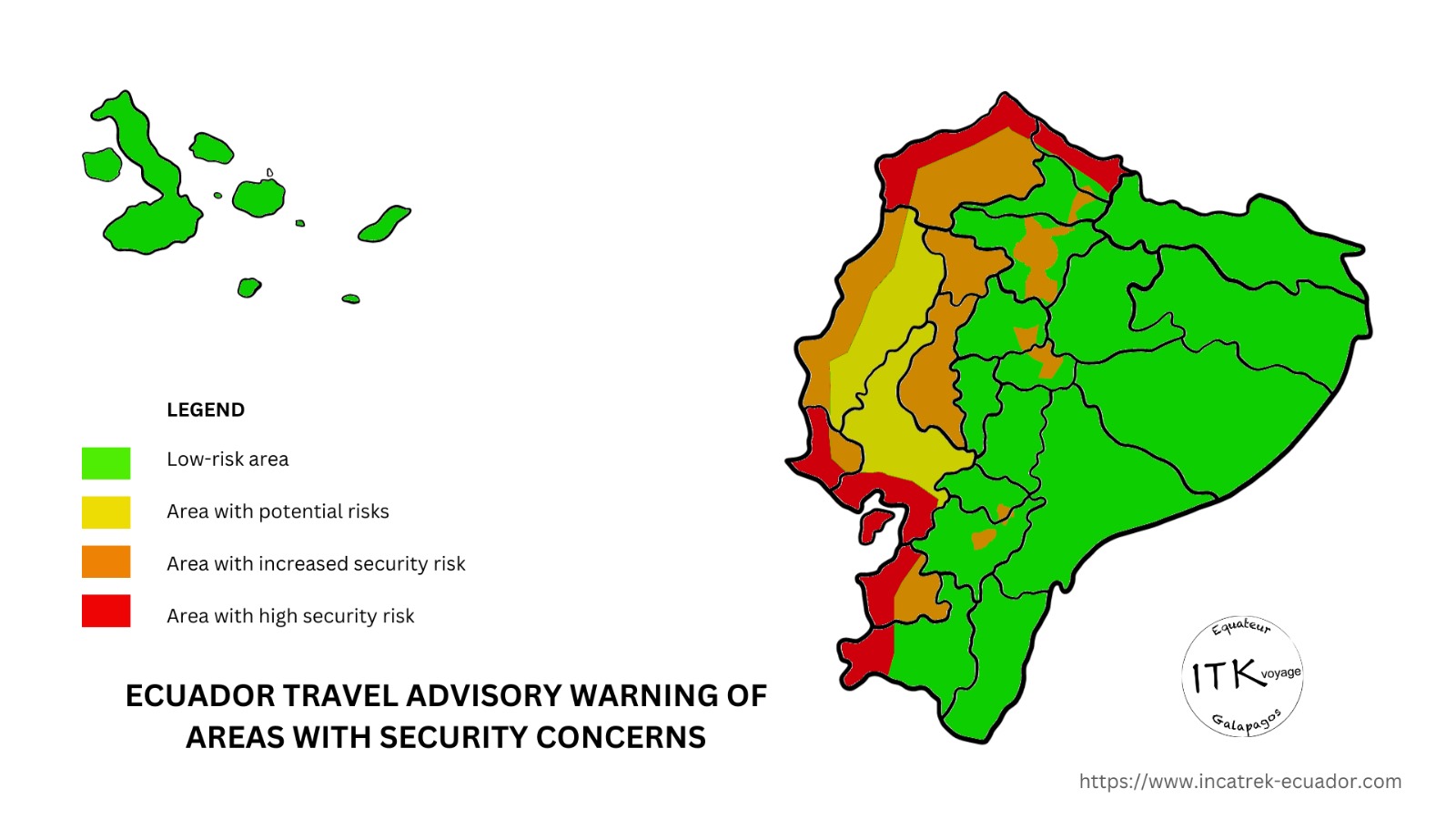
The Plaza San Francisco de Quito, a symbol of everyday life returning to normal
On Friday, January 12, 2024, on the famous square of the San Francisco church in Quito (UNESCO), daily life is also resuming. Security tension in Ecuador: areas to avoid in 2024. Map of areas and regions in Ecuador to avoid for security reasons, as of January 9, 2024.
Ecuador’s Situation Overview
The state of emergency and state of internal armed conflict are in effect for a period of 60 days. During this time, the army and police are deployed throughout the country. Regarding measures for travelers, please note:
- A curfew is in effect from 11 pm to 5 am nationwide.
- The areas of Quito and Guayaquil are particularly tense.
- The government is officially combating drug crime and traffickers by deploying the army in the streets of major cities 24/7.
- We recommend closely following information from local authorities and follow security guidelines.
* We will keep you informed of the situation regularly from Quito and adjust our offerings based on security conditions.
Ecuadorian Ministry of Tourism to our travelers
Tuesday January 9, 2024
- The states of emergency declared by the President of the Republic aim to restore peaceful coexistence in the country, both for Ecuadorian citizens and visitors.
- We emphasize that, despite the state of emergency, travel to and from airports is permitted. This exception ensures that travelers can arrive and depart from Ecuador.
- Connectivity with all air destinations is available. Seaports and airports operate normally, with additional security measures in place at terminals to ensure traveler safety.
- Police and military presence is maintained to protect citizens and visitors.
- Currently, there is no entry ban, and no incidents of violence are reported in the Galápagos Islands, the Amazon region, or national parks, which are the main tourist destinations in Ecuador.
- Hotels and other tourist services provide attention and assistance to clients as usual. However, visitors are advised to stay informed and follow security recommendations from their accommodations and tour operators.
- The government of the Republic of Ecuador, law enforcement, and tourism authorities are working tirelessly to ensure that tourists’ visits to our country are as enriching and safe as ever.
- We want to convey a message of confidence to our future visitors: Ecuador.
* Source: Official announcement from the Ministry of Tourism of Ecuador to the tourist community and the general public dated January 9, 2024, signed by Niels Olsen Peet, Minister of Tourism in Ecuador.
What is the “State of internal armed conflict”?
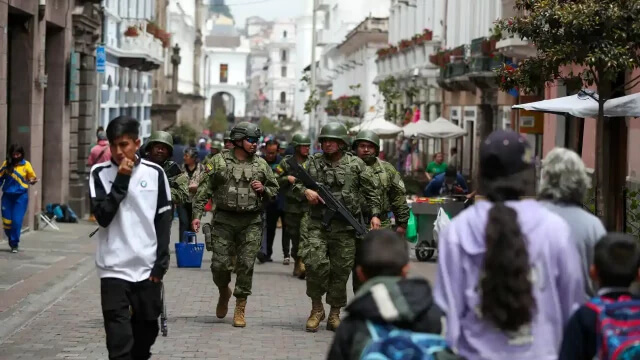
The state of internal armed conflict is an exceptional state declared by the president of Ecuador. It allows the state to take extraordinary measures to address a situation of serious and prolonged violence. The state of internal armed conflict gives the president the following powers:
- He can mobilize the armed forces and police to deal with armed groups.
- He can suspend constitutional guarantees, such as the freedom of assembly and freedom of expression.
- He can decree martial law in certain areas of the country.
- The state of internal armed conflict is valid for a period of 60 days. It can be extended if the situation of violence persists.
In Ecuador, the state of internal armed conflict is a controversial measure. Some believe it is necessary to restore order, while others fear it may lead to human rights violations. Here are some examples of measures taken in Ecuador under the state of internal armed conflict:
- The armed forces have been deployed in areas most affected by violence.
- The police have been authorized to use lethal force against armed groups.
- Laws have been passed to strengthen penalties for drug-related crimes.
It is still too early to say whether the state of internal armed conflict will restore order in Ecuador. Even though out there on the streets the situation may appear to be calming down, the situation remains volatile.
Armed gang storms Ecuador TV studio on air: Hostage-takers were neutralized by security forces
Guayaquil, Ecuador – January 9, 2024
In Tuesday afternoon at the premises of the Ecuadorian TV channel TC Televisión in Guayaquil, armed men, identified as drug traffickers, took journalists and channel employees hostage. This happened following president’s sign of Ecuador’s “state of emergency and curfew”.
A live broadcast by Ecuadorian television station TC was interrupted by a group of armed people who forced staff to the floor, causing great concern in the country. It is unclear whether this incident is related to the disappearance of the of the Choneros gang, Adolfo Macías Villamar, or Fito as he is better known.
After several hours of negotiations, security forces stormed the channel’s premises. The hostage takers were neutralized, and all hostages were freed unharmed.
On January 10, 2024: a deserted Pan-American highway and an empty indigenous market (Pujilí)
The Pan-American Highway is an important route crossing all across Ecuador. Our photographer and local guide, Fernando, shared this short yet revealing video with us, showcasing the current situation out in the field on the Pan-American Highway! It’s a stark contrast to the usual dense and noisy traffic. The reason: the state of emergency and state of internal armed conflict.
At the Pujili market in Ecuador (January 10, 2024)
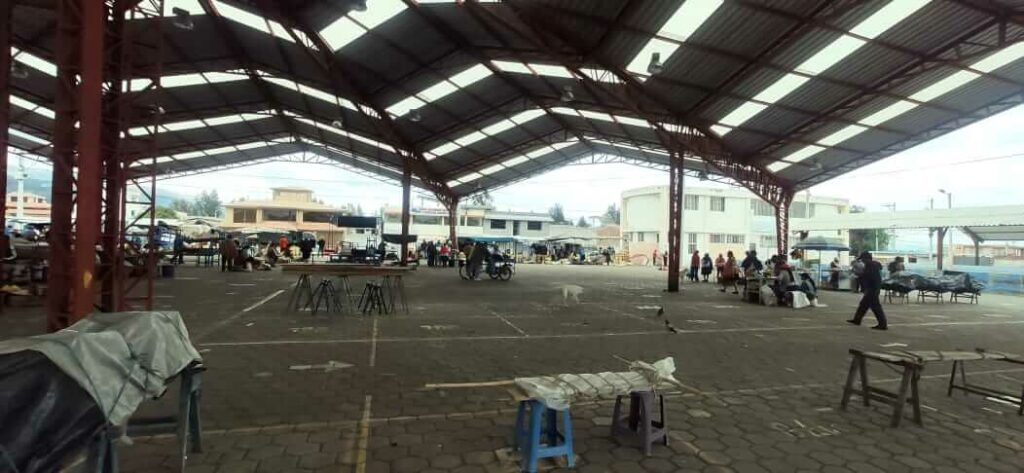
At the Pujili market, the stalls are empty. The sellers, who usually gather there at dawn, stayed at home, huddled in their houses. “It’s because of the fear of Latacunga prison, one of them tells us: “We’re afraid of the escaping prisoners.”



